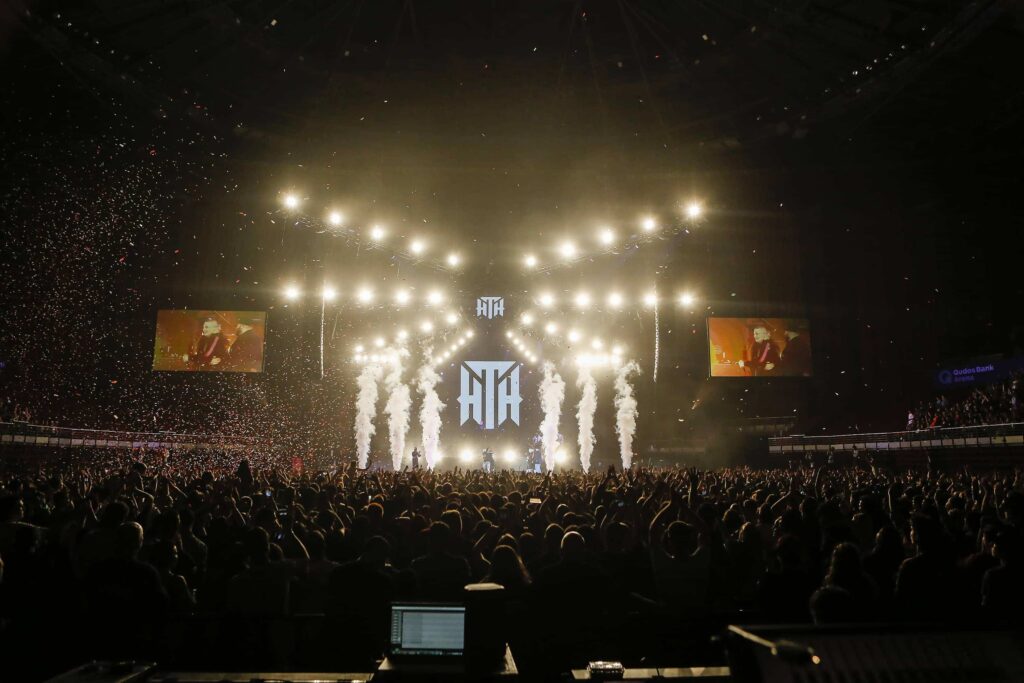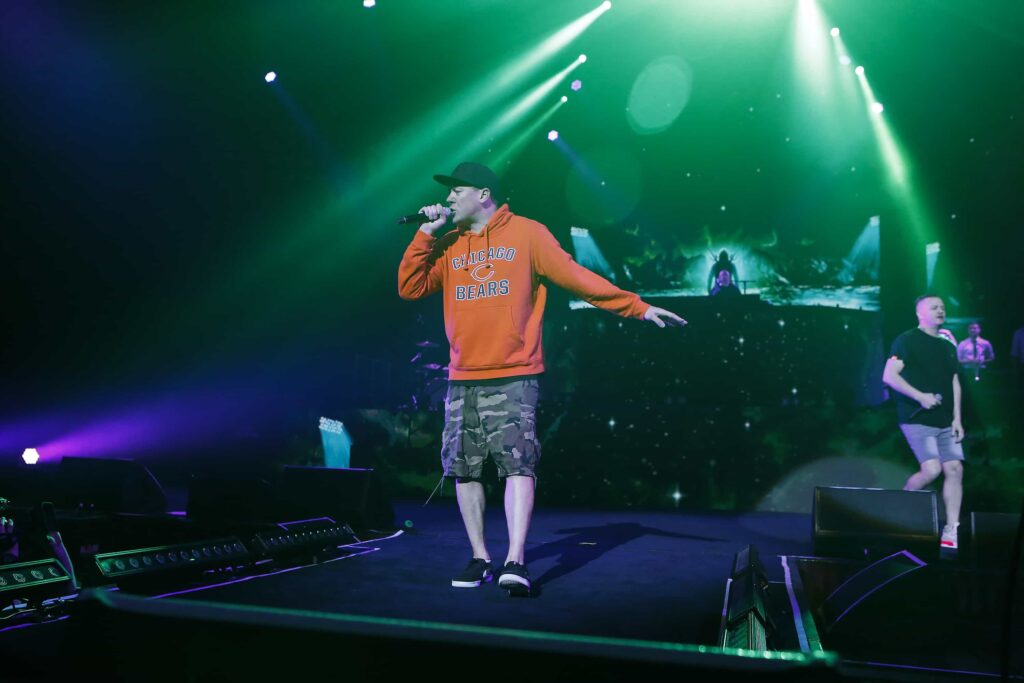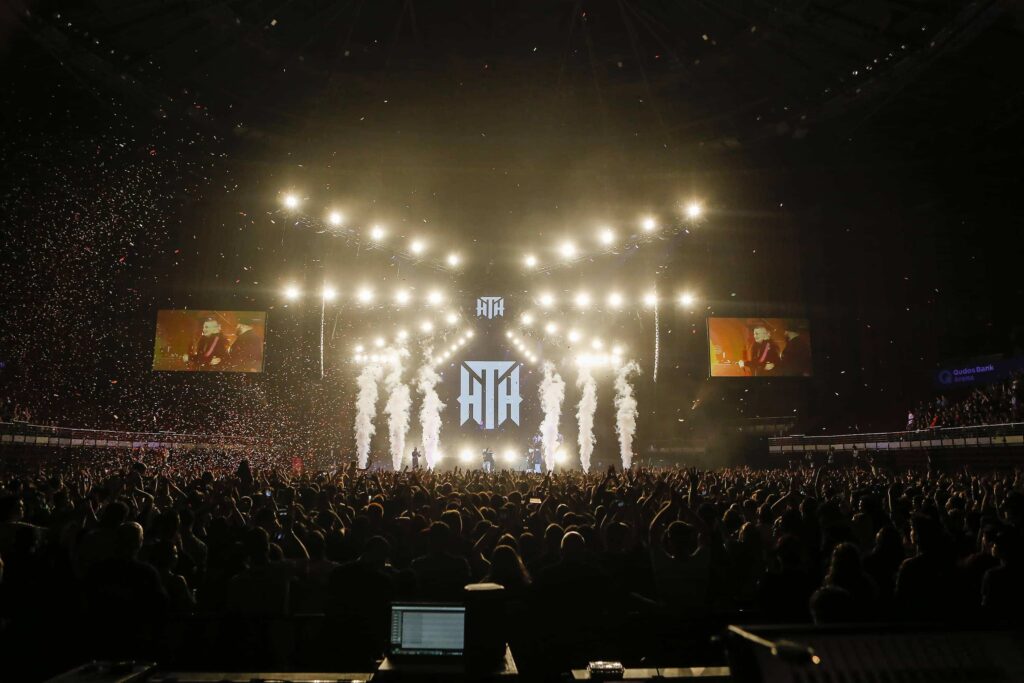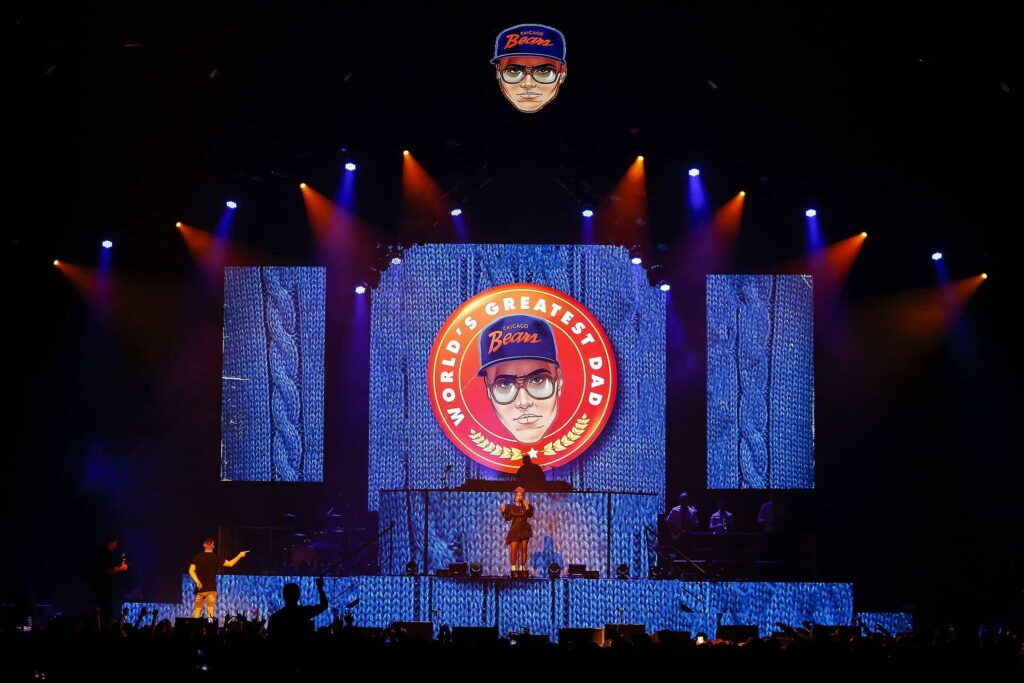News
4 Oct 2019
Hilltop Hoods

Subscribe to CX E-News
ROADSKILLS
by Cat Strom.
Photo Credits: Troy Constable
Australian hip hop group Hilltop Hoods formed in 1994 in Adelaide, South Australia, and over two and a half decades later they are one of the country’s most popular live acts.
In support of the release of their eighth studio album The Great Expanse, which debuted at #1 on the ARIA Album chart, the Hilltop Hoods have embarked on a world tour, playing in 14 countries across the globe.
The Australian leg had them returning to play five capital city headline shows, including two huge shows at Rod Laver Arena.
CX caught up with the show at Qudos Bank Arena where FOH engineer Andrew ‘Muggs’ Kelly, who has mixed for the band for over ten years, utilised his favourite PA; a d&b audiotechnik J-Series comprising 18 J-Series mains and 14 J-Series sides over 20 SL-Subs, all processed on D80 amplifiers.
Added to that were d&b audiotechnik M2 monitor speakers and d&b V8 for side fill. All audio was supplied by JPJ Audio.“The d&b J-Series has the headroom, the cabinets have the grunt, and basically they surpass all other systems,” he noted.
“We used a fairly standard arena set up for that speaker system and it sounded great. Qudos Bank Arena is a really live room and my biggest challenge is to get the band over the noise of the crowd; the Hilltop Hoods’ audience must be the loudest in the country!
“Fortunately the nature of the sound in this arena has a great response and it’s a good space to mix.”
The Hilltop Hoods require a big, bold live sound and Muggs commented that the band has to be mixed from front to back and from side to side so the person in the boondocks gets the same vibe as the person in the front row.
“The best thing about d&b at the moment is its Array Processing, which I believe is the best out there,” he added. “It just dials PAs in beautifully and it’s a big part of my ability to deliver so well. It gives output control across the system and every element.
“Essentially they align across the whole arc and effectively blows soft into the most immediate part of the direct field, which is the crowd on the floor, and it punches harder in the arc where it’s got to reach further.”
When it comes to the FOH mixing console, Muggs admits he’ll use anything and for this tour he had a DiGiCo SD10. “The DiGiCo’s interface is quite handy and efficient to use plus they still feel like a console – not like some other digital consoles,” he added.
“The EQ on them is pretty good, as is the master buss. I have a D2 as a delay unit and a comp as a master over the master mix but everything else is onboard. The effects on the DiGiCo have certainly got better over recent years and their reverbs are pretty cool.”
Microphones include Sennheiser clip-on mics for the toms and regular Shure 57 on the snare top with Muggs saying he won’t use anything else. He also prefers pencil mics for overheads as he favours a more direct sound.
Shure Beta 58 URs are spec’d for wireless as Muggs finds them to be really robust and sturdy, and more natural than the Sennheisers which have a tighter bandwidth through mid and high-mid. “But again I can use anything,” Muggs commented.
“It’s not the microphone that’s making the noise. Your signal flow starts from the performer and you have to manipulate that to make it sound as true as possible.
“There are different natures or nuances to different components of mics, consoles etc but essentially you try to achieve that same end result. There are a lot of really good mics and consoles out there – I know what ‘bad’ is and I don’t like using it. You get familiar and used to how different mics, or combinations of mics, work for you.”
Monitor engineer Hayden ‘Snips’ Ineson was on his first tour with the Hilltop Hoods experiencing their hefty SPL on stage. “They can shake down a lot of monitor engineers, that’s for sure!” laughed Muggs.
“They only have wedges, although they have tried IEMs in the past. I think IEMs are difficult for hip hop and rap acts as they need an attachment to the crowd and feed off that energy. They need volume and interaction and no matter what treatment you use with IEMs, it just doesn’t feel the same.
“The female guest vocalists use IEMs because they can pitch and position themselves in the mix more accurately. When I used to do monitors for the band, I knew if my ears were hurting they were happy!”
“As the band members are very mobile on stage running from side to side, they need a full range and a lot of coverage in their monitor mix. Consequently you have to pump it everywhere so no matter where they’re standing they still feel the punch and position themselves in that mix.”
Pauly Owen, who has been lighting the band for many years, likes to design an arena lighting rig that looks interesting before you even start the show and this time around he didn’t disappoint.
The band wanted to theme the stage to the album The Great Expanse and Pauly racked his brain on how to do this, opting for a central focus point with a large truss configuration expanding out from it. “The central point is a diamond-shaped truss which is filled by video screen,” explained Pauly.
“When I spec’d the screen, I said to Brad Hurle, our video guy, that I wasn’t looking to do anything special or amazing with it – just logos and a few character heads.”
The trussing houses 16 Ayrton MagicPanel-R fixtures of which Pauly is a big fan but he is careful not to overuse them, in fact they don’t put in an appearance until nearly half way through the show.
“When I do I create some really big looks with them and they certainly capture everyone’s attention,” he added. “It’s really a wow moment.”
Radiating out from the diamond truss position are eight large stretches of truss each housing a combination of 34 Martin MAC Viper Performance, 32 Claypaky Sharpys, and 36 GLP impression X4 LED washes. The two front trusses provide front lighting as well as multiple layers that Pauly can play with for different parts of songs.
“Essentially I need them to cover the guys on stage as front wash, but I’m big on layers, so everything in the rig has a multiple use,” he said. “I angled the trusses so I can get a good front, mid and back truss arrangement across the stage to cover everyone I need to.
“I look at where the Sharpys sit first because there are one or two looks where they all project straight out from the stage so I wanted an even coverage of them, although different and dynamic because of the way they’re sitting from the truss. Then it’s essentially spot then wash all the way through the rig.”
Pauly has always done Hilltop Hoods shows in the spot then wash manner, saying they’re the fixtures that fill in the gaps, do all the colours and beams. That tried and tested formula allows him to light the band properly, and then build on the design.
Scattered through the rig are 32 Martin Atomic 3000 strobes whilst GLP JDC-1s are located on the stage floor to light the band and fill dark spots with colour, especially up on the backline which can seem dark due to the surrounding bright video screens. They do the occasional strobe effect with random chases thrown in.
A catwalk that juts out from the stage has eight Elation SixBar 1000 to provide footlight and make the band members feel closer to the crowd when they’re out there! Two massive pods, similar to stadium sports lights, echo the album cover adding an incredibly dynamic element to the stage lighting. It’s a big look that Pauly cleverly does not overuse.
Each pod contains 32 Martin RUSH PAR2 RGBW, with Pauly utilising the zoom function, and five Martin MAC1001s suspended from beneath the pod. Ten more MAC101s are located in front of the backline riser.
Pauly decided to incorporate GLP KNV Dots into his rig as the band have incorporated stars into the cover artwork of several albums, including the recent release. “The brief was to create a starry look within the arena. I scratched my chin over this for a little while,” Pauly said.
“Initially I thought of using a bit more outrig pipe and random lengths
of cable with the SGM balls which come in a string of eight. The question was whether they would be bright enough for an arena. Then I heard that Above & Beyond had just acquired the GLP KNV Dots and they suited the bill to a tee.”
Unfortunately they were only able to get 60 units so there were probably a few spots in the arena that didn’t get the starry look but from FOH it looked very pretty! Twenty of the KNV Dots are on droppers hung at different heights randomly through the front four trusses, as well as around the diamond, filling in the centre.
As with most hip hop acts, interaction with the audience is paramount hence a large number of 2-light and 4-light molefays are used to light up the audience to make them feel a part of the show.
“Not wanting to overuse them, I spread them throughout the rig to give a lot of range,” explained Pauly. “That way, each song can have a different grouping and look to the molefays.”
Control was an Avolites Sapphire along with an Avolites Tiger Touch console as backup with Pauly being one of the LDs waving the Avolites flag in Australia. “People can be skeptical when they first see the console, but by the end of the show they’re more than impressed,” he said.
“I’m just very familiar with the platform as I’ve been using Avo ever since I first started programming and running moving light shows. It just works for how I approach a light show plus it’s very intuitive.
“It’s easy and fun to play with – it feels like you’re playing rather than clunking over stuff. It’s as deep and powerful as an MA console can be but you don’t have to take 10 steps to achieve the same thing!”
The tour lighting was supplied by PRG, with Above & Beyond Production Services supplying the KNV Dots, Aryton MagicPanels, and Avolites Tiger Touch console.
CX Magazine – Oct 2019 Entertainment technology news and issues for Australia and New Zealand – in print and free online www.cxnetwork.com.au
© CX Media
Subscribe
Published monthly since 1991, our famous AV industry magazine is free for download or pay for print. Subscribers also receive CX News, our free weekly email with the latest industry news and jobs.
































